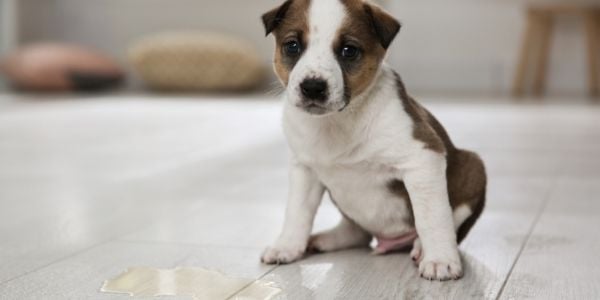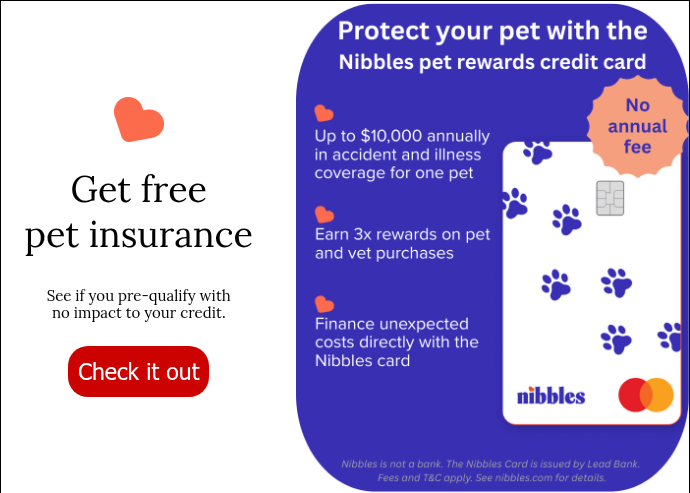
Potty training a dog in an apartment presents unique challenges that aren't typically encountered in a house with a yard. With limited outdoor space, long hallways, stairwells, or elevators, it can get quite complicated.
Getting your puppy out to a grassy spot to potty when you live in an apartment can be a challenge. There may be a pee accident before you even get there, considering a puppy's small bladder and physical inability to "hold it."
Plus, your new dog may not have all the needed puppy vaccines to make going to a communal dog area in your apartment complex safe! But I've got some tips on how to navigate the potty training process in an apartment setting, along with ways to make it easy for your puppy and convenient for you.
6 Tips for Potty Training a Dog in an Apartment
1. Create a Puppy-Safe Designated Potty Spot
Because you shouldn't take younger puppies waiting for their vaccinations to areas other dogs use as a bathroom, you need to create a puppy-safe potty spot, either in your apartment or on your patio (if you have one).
If you plan on using potty pads for the life of your dog, which can be very convenient if you have a small dog and live in a high-rise apartment building, then regular potty pads are just fine. Pee pads typically contain scents that will attract your dog to eliminate on the pad. There are reusable, washable ones, too.
You can help teach your dog to use the pad by praising when your pup successfully uses it or placing them on the pad when they show signs of needing to eliminate. Pee pads can sometimes make outdoor potty training more difficult for your puppy — read about the pros and cons of pee pad training here.
If your long-term goal is to train your dog to potty only outside, you should only use a real-grass option, such as a Fresh Patch.
I prefer the real grass options because 1) they're more ecologically friendly, 2) the plastic kind can be disgustingly messy, 3) you can set up a delivery subscription and then toss these in your yard waste when used up, and 4) there's a benefit of real grass for future transition to outdoor-only potty training.
Puppies can imprint on what surface is okay to potty on, so if they are trained from a young age that the designated potty area is grass, then transitioning to outdoors only is easier because they see grass as where to go. Compare this to re-training them to potty on grass or dirt after only having used paper or fabric pads.
Here's a video of my dog when he was a puppy using his Fresh Patch on our front patio (which was mostly concrete) until he was old enough to go for walks around our neighborhood block for bathroom breaks:
If you don't want to set up a subscription service for specially-grown grass dog spots, you can make your own real-grass option. Check out this video to see how:
You can even make a DIY version of a porch potty, check out this video below to see how.
Pro Tip: If you're using potty pads or a porch potty, you'll want somewhere convenient to throw away any waste. Instead of making the trek to the dumpster every time you pick up your puppy's poo, invest in a small dog waste station with deodorizer, like this one from PetFusion.
It has a locking lid and includes a charcoal filter that helps reduce odor, and it's lightweight and portable — making trips to toss the poo in your apartment complex's garbage less frequent and easier!
2. Keep a Regular Routine
Create a regular schedule of feeding and potty breaks since they are closely linked! Younger puppies will need more frequent potty breaks since they cannot hold it as long as older puppies or adult dogs.
For the best chances of success, start by taking your puppy to their designated spot every hour, or more frequently if your pup is very young. Plan for potty breaks immediately after waking or coming out of their crate and within about 5–10 minutes after eating, drinking, or playing.
Use our downloadable Puppy Potty Log to track your puppy's elimination schedule and get a better idea of when they need to be taken outside.
3. Reinforce Going Potty in the Right Place
Be sure to lavish your puppy with praise and give them a treat every time they successfully go in the proper location. Quick tip: don't start praising or grabbing the treat until after they've finished going potty. Otherwise, you run the risk of interrupting them, and they might not be totally "empty."
You can even teach your dog to go potty on cue by following these 4 easy steps.

4. Watch for Signs Your Puppy Needs to Go Potty
Certain behaviors mean that your dog may need to go, such as:
- Restlessness
- Sniffing
- Circling
- Suddenly stopping play
- Seeking out a corner or hidden spot
- Going to the door that leads to their potty spot
If you notice these signs, it may be too late to make it all the way outside, but you can successfully snatch up your pup and place them on their designated indoor or patio potty spot.
5. Deal with Puppy Potty Accidents the Right Way
Outside may be several flights of stairs away or a few minutes riding in an elevator, which means a greater likelihood of an accident along the way.
If your dog pees in your home, resist the urge to scold them or “rub their nose in it,” as this will instill fear and undermine your relationship with your dog. This technique just teaches your puppy to hide where they go potty. Plus, science shows that such punishments miss the mark anyway.
Be sure to clean accidents immediately with an enzymatic cleaner to remove all traces. Miss this odor-neutralizing step, and the lingering odor will keep your pup coming back for more! Read more on properly cleaning up potty accidents. Dogs are likely to continue to pee in the same place if it smells like urine.
Along with poo bags, equip yourself with an old rag, paper towels or spare napkins, and a small bottle of cleaner. Accidents can also happen in the hall or elevator on the way to your potty destination! And your neighbors will certainly appreciate it if you're armed and ready to deal with such mishaps promptly.
6. Carry Your Puppy Outside
If you're working on transitioning to outside-only potty breaks or don't have an indoor potty spot set up, carry your pup down the hall and in the elevator until you’ve reached your potty destination. As they get older and more reliable with their potty habits, you can start letting them get there using their own four paws.
Extra Puppy Potty Training Tools
Crate Training: Dogs don’t want to go potty in their sleeping area, so crate training can help prevent late-night accidents. If the crate is significantly larger than your pup (leaving room for growth), be sure to block off part of the crate so your puppy can’t pee on one side and sleep on the other. Here are some tips on where to start with puppy crate training.
A Puppy Zone/Long-Term Confinement Area: If you need to leave your puppy alone longer than they can handle being confined in a crate, set up a long-term puppy zone with an appropriate potty area using pee pads or the real-grass option. Learn how to set up your puppy's confinement area here.
Umbilical Cord Leash: Use a hands-free leash to keep your puppy attached to you while inside, so they can't wander off and have an accident. Keeping them close helps you notice when they are giving signals they need to go outside to potty.
With plenty of patience and practice, your new dog will learn the appropriate places to go potty, even if it means patiently waiting for the elevator to reach the ground floor.
Stop potty accidents and get help with house training in our Puppy Essentials: Potty Training Workshop
Includes unlimited access to self-paced lessons, downloadable resources, video demonstrations, and more — all for only $9.







